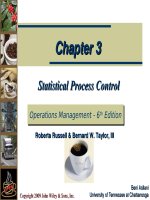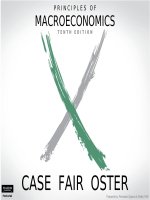Management by hitt back porter CH03
Bạn đang xem bản rút gọn của tài liệu. Xem và tải ngay bản đầy đủ của tài liệu tại đây (365.65 KB, 31 trang )
Chapter 3
Assessing
External
Environments
PowerPoint slides by
R. Dennis Middlemist
Colorado State University
Learning Objectives
After studying this chapter, you should be
able to:
2
Articulate the role of the external
environment in management decisions
and effectiveness.
Explain the five major dimensions of an
organization’s general environment.
Describe the critical forces in the
organization’s task environment.
©2005
Learning Objectives
After studying this chapter, you should be
able to:
3
Describe the key elements of an
organization’s global environment.
Describe the key considerations in
conducting effective environmental
scanning.
©2005
The Business Environment
External environment: a set of forces and
conditions outside the organization that can
influence its performance
Task environment: forces that have a high potential of
affecting the organization on a immediate basis
General environment: forces that typically influence the
organization’s external task environment and through them,
the organization itself
Internal environment: key factors and forces inside
the organization affecting its operation
4
©2005
Organization Environment
io
Soc
General
Environment
ol
og
y
Eco
ural
cult
nom
ic
External Environment
General Environment
o
l
G
l
a
b
Te
ch
n
Political-Legal
5
©2005
Adapted from Exhibit 3.1: Organization Environment
Organization Environment
ers
y
nom
ic
s
or
ula
t
Eco
or
Re
g
b
La
ural
cult
General
Task
Environment
Environment
s
er
io
Soc
Cu
sto
m
ol
og
li
pp
Task Environment
Competitors
Su
External Environment
General Environment
o
l
G
l
a
b
Te
ch
n
Strategic Partners
Political-Legal
6
©2005
Adapted from Exhibit 3.1: Organization Environment
Organization Environment
nom
ic
s
or
Eco
or
Re
g
b
La
ural
cult
Owners
BoardTask
of Directors
Management
Environment
Employees
Culture
ula
t
ers
Cu
sto
m
y
s
er
io
Soc
Internal Environment
Internal
Environment
ol
og
li
pp
Task Environment
Competitors
Su
External Environment
General Environment
o
l
G
l
a
b
Te
ch
n
Strategic Partners
Political-Legal
7
©2005
Adapted from Exhibit 3.1: Organization Environment
©2005
hn
ol
og
y
Eco
n
l
8
l t u ra
Economic forces
Current economic conditions
Economic cycles
Structural changes
iocu
Product technological changes
Process technological changes
Te
c
General
Environment
So c
Sociocultural forces
Demographics
Values
Technology forces
al
ob
Gl
omi
c
General Environment
Political-Legal
Economic Cycles
Good
economic
conditions
Poor
economic
conditions
Time
9
©2005
Adapted from Exhibit 3.2: Overall Economic Cycles and Industry Cycles
l t u ra
l
Political-Legal
Global forces
Impact on and interaction with the other
forces
Institutional forces
Physical forces
10
©2005
ol
og
y
Eco
n
iocu
Government spending
hn
General
Environment
So c
Political and legal forces
Laws and regulations
Te
c
al
ob
Gl
omi
c
General Environment
General Environment of
Coca-Cola
Environmental Factor
Sociocultural
Demographics
Description
Baby boomers drinking less soft drinks as
they age
US population growth is slowing and much
of the growth comes from immigrants who
generally drink less soft drinks
Values
Baby boomers drinking less soft drinks as
they age
US population growth is slowing and much
of the growth comes from immigrants who
generally drink less soft drinks
11
©2005
Adapted from Exhibit 3.3: Description of the General Environment of Coca-Cola
General Environment of
Coca-Cola
Environmental Factor
Technological
Description
New “canning” technology makes using
recycled aluminum easier and cheaper
Internet opens up a new means of running
promotion contests and activities
Economic
Slow economy reduces per person
consumption due to fewer social occasions
at which soft drinks might be served
Like end of economic downturn and
prospects of economic recovery
Stricter liability for illness caused by
beverage contamination
12
©2005
Adapted from Exhibit 3.3: Description of the General Environment of Coca-Cola
The General Environment of
Coca-Cola
Environmental Factor
Global
Description
Gradual increase in acceptance of
carbonated soft drinks in other countries
such as India and China
Widely available electricity and increased
ability to afford refrigerators in emerging
countries and economies
13
©2005
Adapted from Exhibit 3.3: Description of the General Environment of Coca-Cola
The General Environment of
Coca-Cola
Technological
Sociocultural
Sociocultural
Technological
Political-Legal
Global
Economic
•
•
•
•
Baby boomers drinking less
Immigrants drinking less
Concern about recycling
Concerns about health
Economic
•
•
•
•
New recycle-friendly canning
technology
New promotion opportunities
via the Internet
Political-Legal
Coca-Cola
•
Slow economic growth
Prospect of economic recovery
•
Increased health standards
for bottling
Stricter liability legislation
Global
•
•
14
©2005
Increase in acceptance of
carbonated drinks in India
and China
Easier consumer access to
refrigeration
Adapted from Exhibit 3.4: The General Environment of Coca-Cola
Task Environment
Strategic partners
Labor
Suppliers
Regulators
Cu
s
ula
t
Re
g
Task
Environment
or
s
rs
Competitors
Customers
r
bo
La
external environment
Consists of
lie
Organization’s most immediate
pp
tom
Su
er s
Competitors
Strategic Partners
Typically largest influence on the organization
Managers must understand the fit between the
organization and its task environment
15
©2005
Profits and Industry Forces
•
•
•
•
•
•
•
16
Few competitors
Quality-based
competition
High entry barriers
Few new entrants
Many customers
Fragmented
customers
Many suppliers
©2005
•
•
•
Higher
Profits
•
•
•
•
•
Many competitors
Price-based
competition
Low entry barriers
Many new entrants
Many substitutes
Few customers
United customers
Few suppliers
Lower
Profits
Adapted from Exhibit 3.5: Profits and Industry Forces
Task Environment:
The Nature of Competition
pp
tom
Su
er s
Competitors
rs
Cu
s
lie
ula
t
What are your competitors weaknesses?
Re
g
r
bo
La
Environment
or
s
How big and strong are your competitors?
Task
Strategic Partners
What is the nature of competition or rivalry
in your industry?
17
©2005
Task Environment:
New Entrants—Potential Competitors
New entrants increase competition
Increased competition leads to lower profits
More choices for customers causes
companies to increase value to customers
Entry barriers keep new entrants out
18
©2005
Task Environment:
Substitutes
Strategic Partners
19
©2005
or
s
ula
t
Re
g
r
bo
La
products
Task
Environment
or services can
substitute for
existing product
or service
The fewer the available substitutes, the
greater the profits
rs
Cu
s
lie
To what extent can alternative
pp
tom
Su
er s
Competitors
Task Environment:
Customers
rs
Cu
s
lie
Strategic Partners
20
©2005
or
s
customers, they have
demand
Lower prices
Customized products or services
Attractive financing terms from producers
These demands reduce profits
ula
t
r
bo
La
united
more power to
Task
Environment
Re
g
When there are fewer and
pp
tom
Su
er s
Competitors
Task Environment:
Strategic Partners
©2005
Cu
s
rs
21
ula
t
Re
g
Task
Environment
or
s
with
beneficial goals
r
bo
La
a firm to pursue mutually
Limited engagements
Joint ventures
Sharing of equity interest
lie
Strategic partners work closely
pp
tom
Su
er s
Competitors
Strategic Partners
Task Environment:
Labor
The balance between supply and demand
for types of workers significantly affects a
firm’s performance
When demand exceeds supply, the
imbalance can lead to high labor costs
Labor unions can exert pressure on
managers to increase wages and offer other
costly benefits, decreasing performance
22
©2005
Task Environment:
Regulators
rs
Cu
s
lie
regulatory
Task
Environment
agencies and
interest groups
Regulators can influence and sometimes
dictate organizational actions
Re
g
ula
t
r
bo
La
or
s
Regulators consist of both
pp
tom
Su
er s
Competitors
Strategic Partners
23
©2005
Task Environment of JetBlue
Task Environmental
Factor
Competitors
Rivalry
Description
Primarily price-based, hurting performance
Many established and big players
New Entrants
$35 million start-up costs, frequent failures
discourages new entrants
Substitutes
$ Video conferencing may substitute for
face-to-face (travel) business meetings
Customers
Business travelers who want convenience
Leisure travelers who want low price
24
©2005
Adapted from Exhibit 3.6: Description of the Task Environment of JetBlue
Task Environment of JetBlue
Task Environmental
Factor
Suppliers
Description
Airbus supplies all of JetBlue’s planes
Many jet fuel suppliers
Strategic Partners
Currently not a part of any airline alliance
Initial partner with satellite TV provider
Currently not represented by labor unions
Ample supply of pilots and flight attendants
due to significant downsizing in industry
Regulators
FAA dictates standards and regulations
Airport authorities determine access and
cost of landing slots and gates at airports
25
©2005
Adapted from Exhibit 3.6: Description of the Task Environment of JetBlue









